In memory of illustrator Istvan Banyai,
who reportedly died on Dec. 15, 2022 . . .
https://www.nytimes.com/2023/02/18/
arts/istvan-banyai-dead.html —
In memory of illustrator Istvan Banyai,
who reportedly died on Dec. 15, 2022 . . .
https://www.nytimes.com/2023/02/18/
arts/istvan-banyai-dead.html —
"US actor Stewart, who previously depicted Princess Diana
in Spencer, is president of the international jury at the 73rd
Berlin International Film Festival, where filming will begin for
the project." — Mona Tabbara at screendaily.com, 10 Feb. 2023
From an earlier Berlinale . . .
This post was suggested by Peter Woit's weblog today and by . . .
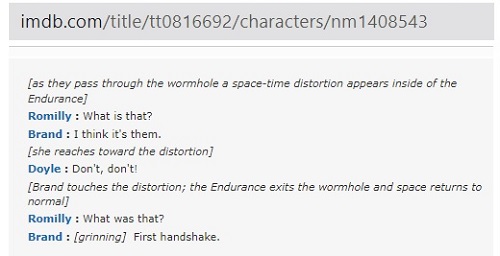
Update of 4:48 PM ET on Friday, Feb. 17, 2023 —
Other Norman-Yao-related reading —
In memory of a Harvard Corporation Senior Fellow
who reportedly died at 86 on December 20, 2022 —
See http://m759.net/wordpress/?s="Mac+Lane"+Boolean.
An image from that search —
 .
.
A related image
for T. S. Eliot:

"And then there’s the ultimate unknown known:
the 'enlightenment' (satori, kensho) of Zen practice.
If my sense of it from accounts I have read is accurate,
it involves seeing the world and realizing that you always
knew its true nature, but you just didn’t know you knew…
because you were too busy putting it into boxes and
matrices and categories and words. Which reminds us
again that while logical deductions and categorizations
can lead us to discoveries, they can also lead us away
from them."
— James Harbeck on Groundhog Day, 2023
This post was suggested by a Log24 image from All Saints' Day, 2018 —

Related verbiage: Unthought Known.
Mathematics:
From Log24 "Pyramid Game" posts —
The letter labels, but not the tetrahedron, are from Whitehead’s
The Axioms of Projective Geometry (Cambridge U. Press, 1906), page 13.
Narrative:
The above title is a commercial slogan from Westinghouse Studio One —
in particular, from its "June Moon" broadcast on June 22, 1949.
The date August 4, 2011, from the previous post suggests a review . . .
Related search results —

From a different Adelson, in a Log24 post from 2003 —
Related geometric entertainment —

"Zwei Seelen wohnen, ach! in meiner Brust,
die eine will sich von der andern trennen:
Die eine hält in derber Liebeslust
sich an die Welt mit klammernden Organen;
die andre hebt gewaltsam sich vom Dust
zu den Gefilden hoher Ahnen."
— Faust 1, Vers 1112 – 1117; Vor dem Tor. (Faust),
according to www.gutzitiert.de.
A version in English: "In me there are two souls."
This post was suggested by a New York Times obituary today.

"These are not the examples most of us want to follow."
The New York Times on a set designer who
reportedly died at 83 on Monday (Feb. 6, 2023) —
"Adrian Hall, the founding artistic director,
brought him in as resident designer.
(Mr. Hall died on Feb. 4 in Van, Texas.)"
Hall was the founding artistic director of
Trinity Repertory Company, Providence, R.I.

Not-so-holy writ ….
Panthers — "Dimensions," Log24, Feb. 5, 2023.
Beast Belly — Tonight's previous post, "Gutter Mathematics."
From the Feb. 7 post "The Graduate School of Design" —
Related material —
Illustrations — From The previous post . . .

From Google —

Call a 4×4 array labeled with 4 copies each
of 4 different symbols a foursquare.
The symmetries of foursquares are governed
by the symmetries of their 24 interstices —

(Cullinane, Diamond Theory, 1976.)
From Log24 posts tagged Mathieu Cube —
A similar exercise might involve the above 24 interstices of a 4×4 array.
See "Two Approaches to Local-Global Symmetry"
(this journal, Jan. 19, 2023), which discusses
local group actions on plane and solid graphic
patterns that induce global group actions.
See also local and global group actions of a different sort in
the July 11, 1986, note "Inner and Outer Group Actions."
This post was suggested by some remarks of Barry Mazur,
quoted in the previous post, on " Wittgenstein's 'language game,' "
Grothendieck, global views, local views and "locales."

Further reading on "locales" — Wikipedia, Pointless topology.
The word "locale" in mathematics was apparently* introduced by Isbell —
ISBELL, JOHN R. “ATOMLESS PARTS OF SPACES.”
Mathematica Scandinavica, vol. 31, no. 1, 1972, pp. 5–32.
JSTOR, http://www.jstor.org/stable/24490585.
* According to page 841 of . . .
Johnstone, P. (2001). "Elements of the History of Locale Theory."
Pp. 835–851 in: Aull, C.E., Lowen, R. (eds) Handbook of the
History of General Topology, Vol 3. Springer, Dordrecht.
The epigraph to Chapter 2 of Category Theory in Context by Emily Riehl —

[Maz16] Barry Mazur. Thinking about Grothendieck.
Notices of the AMS, 63(4):404–405, 2016.
The above epigraph in context, in a paper dated
January 6, 2016 (Epiphany) —

Also on Epiphany 2016 —
Wednesday, January 6, 2016
|
The above cubic equation may also be written as
x3 – x – 1 = 0.
The equation occurred in my own work in 1985:
An architects' equation that appears also in Galois geometry.
For further details on the plastic number, see an article by
Siobhan Roberts on John Baez in The New York Times —

Perhaps Crossan should have consulted Galois, not Piaget . . .
From Hermann Weyl's 1952 classic Symmetry —
"Galois' ideas, which for several decades remained
a book with seven seals but later exerted a more
and more profound influence upon the whole
development of mathematics, are contained in
a farewell letter written to a friend on the eve of
his death, which he met in a silly duel at the age of
twenty-one. This letter, if judged by the novelty and
profundity of ideas it contains, is perhaps the most
substantial piece of writing in the whole literature
of mankind."
Epigraph to The Dark Interval , by John Dominic Crossan —
“I am the pause between two notes that fall
into a real accordance scarce at all:
for Death’s note tends to dominate—
Both, though, are reconciled in the dark interval,
tremblingly.
And the song remains immaculate.”
—Rilke, The Book of Hours , I


"What we do may be small, but it has
a certain character of permanence."
— G. H. Hardy in A Mathematician's Apology
For Bill Irwin —
<meta property="article:published_time"
content="2023-02-06T11:00:00.000Z"/>
The Source —
view-source:https://www.newyorker.com/magazine/2023/02/13/
finding-laughs-amid-the-gray-in-becketts-endgame
See as well the previous post and . . .
|
You, Xi-lin; Zhang, Peter. "Interality in Heidegger."
The term "interology" is meant as an interventional alternative to traditional Western ontology. The idea is to help shift people's attention and preoccupation from subjects, objects, and entities to the interzones, intervals, voids, constitutive grounds, relational fields, interpellative assemblages, rhizomes, and nothingness that lie between, outside, or beyond the so-called subjects, objects, and entities; from being to nothing, interbeing, and becoming; from self-identicalness to relationality, chance encounters, and new possibilities of life; from "to be" to "and … and … and …" (to borrow Deleuze's language); from the actual to the virtual; and so on. As such, the term wills nothing short of a paradigm shift. Unlike other "logoi," which have their "objects of study," interology studies interality, which is a non-object, a no-thing that in-forms and constitutes the objects and things studied by other logoi. |
Some remarks from this journal on April 1, 2015 —
Manifest O
|
| 83-06-21 | An invariance of symmetry The diamond theorem on a 4x4x4 cube, and a sketch of the proof. |
| 83-10-01 | Portrait of O A table of the octahedral group O using the 24 patterns from the 2×2 case of the diamond theorem. |
| 83-10-16 | Study of O A different way of looking at the octahedral group, using cubes that illustrate the 2x2x2 case of the diamond theorem. |
| 84-09-15 | Diamonds and whirls Block designs of a different sort — graphic figures on cubes. See also the University of Exeter page on the octahedral group O. |
The above site, finitegeometry.org/sc, illustrates how the symmetry
of various visual patterns is explained by what Zhang calls "interality."
Patterns in the space
between subsquares —
Figures in the space
between fingers —


A different NAM that some will prefer —
Experiential Events in this journal
on the above DC program date —

A Logo for Riri —

The above Nick Romano passage is from Knock on Any Door,
a 1947 novel by Willard Motley. Another Motley novel about
Chicago, from 1958 . . .
|
Page 41 The city was a blue-black panther that slunk along beside them. The tall, skyscraper night-grass hemmed them in. The thousand neon animal eyes watched their going. Page 67 The blue-black panther of a city watched their going. The un- blinking neon animal eyes watched their going. Thousands of neon signs lit their way. In an alley behind West Madison Street half an Page 68 hour before, a bum, drunk, had frozen to death lying in the back doorway of a pawnshop. The blue-black panther crouched over him. Page 70 First the creak of ice as an automobile goes by. Then the frown into your room of the red brick building across the street, its windows frosted over like cold, unfriendly eyes. Then a bum stumbling along trying to keep warm. Now a drunk, unevenly. And the wind like the howling voice of the blue-black panther, hunting, finding. And the clanging of impersonal streetcars. And each bar of neon, cold, dead. No message. The clown takes his bow and it is Christmas Day. Page 79 The blue-black panther followed them, sniffing at their heels. Page 106 Above them the blue-black panther lay on the roof of a tenement house, its feline chin on the cornice, its yellow-green eyes staring down onto the black night street of Maxwell. Its tail, wagging slowly back and forth, was like a lasso, a noose, sending little shivers of pebbles rolling loosely across the roof. Page 154 Then he went down to the Shillelagh Club. Through the pane, in the crowded, noisy place, he saw her. She was sitting at a table near the back, alone. Her cigarette had fallen from her lips and rolled away from her on the table top. It had burned itself to a long gray ash. Her head hung loosely on her neck as if she was asleep. A half-empty glass of beer was in front of her. Please, Mother, please come out, he prayed to her. And he stood next door to the tavern, waiting, his small shoulders drawn in, his head down in shame. And often he walked to the window and stood on tiptoe. She was still there. In the same position. He waited. He would be late to school tomorrow. He waited, keeping the long vigil. He waited. Twelve years old. And the thousand neon-animal eyes stared at him savagely. He waited. The blue-black panther lashed out its tail, flicking its furry tip against his ankles. He waited. Page 250 Alongside the blue-black patrol wagon the blue-black panther walks majestically. Page 262 Outside the door the blue-black panther rubs its back like a house cat. Page 409 Nick held the cigarette listlessly. The smoke curled up his wrist and arm like a snake. The blue-black panther licked his hand. |
("Miniaturist of Modernism" → "Windows on World")
(Women's Center → Central Intelligence)
This post was inspired by eBay —

On a concert at Carnegie Hall
on Saturday, Jan. 28, 2023 —
"The ravished NYT reviewer offers
some nice writing …."
Related Log24 posts —
"Just 17," Dec. 17, 2020, and
"Just 17," June 17, 2022.

"The child is father of the man." — Wordsworth
"Suck any sense from that who can." — Hopkins
Illustration —
See as well Expanding the Spielraum.
From Wednesday, St. Bridget's Day, 2023 —
Poetic meditation from The New Yorker today —
"If the tendency of rhyme, like that of desire,
is to pull distant things together
and force their boundaries to blur,
then the countervailing force in this book,
the one that makes it go, is the impulse
toward narrative, toward making sense of
the passage of time."
"Intended for a white European male audience, the sensual
reclining nude belongs to a long artistic tradition."
— The Courtauld Gallery on Gaugin's "Nevermore" (1897)
"After decades abroad, Mr Doig has returned again to London.
On February 10th he opens a new exhibition at the Courtauld Gallery ….
The Courtauld is also the home of Britain’s finest Impressionist collection,
and some of the paintings in the new show recall and respond to those works.
A depiction of an alpinist by Mr Doig speaks to Paul Cézanne’s view of
Lake Annecy, a tropical bather . . . gestures at Paul Gauguin’s nude
'Nevermore'."
— https://www.economist.com/culture/2023/02/02/
look-closely-at-peter-doigs-paintings-then-look-again
The London School of Economics has a more direct approach to art —
"When the Washington Post unveiled the slogan
'Democracy Dies in Darkness,' on February 17, 2017,
people in the news business made fun of it.
'Sounds like the next Batman movie,' the New York Times’
executive editor, Dean Baquet, said."
— Louis Menand in The New Yorker ,
"When Americans Lost Faith in the News," Jan. 30, 2023.
See also Darkness in this journal.
Not so dark:
A Log24 post from February 17, 2017
regarding that year's Groundhog Day — The dies natalis
(in the Catholic sense) of St. Bertram Kostant.
From tonight's previous post —
"here I come again . . . the square root of minus one,
having terminated my humanities" —
Samuel Beckett, Stories and Texts for Nothing
(New York: Grove, 1967), 128.
|
From The French Mathematician 0
I had foreseen it all in precise detail. i = an imaginary being
Here, on this complex space, |
Related reading . . .
See also "William Lawvere, Category Theory, Hegel, Mao, and Code."
( https://www.reddit.com/r/socialistprogrammers/comments/m1oe88/
william_lawvere_category_theory_hegel_mao_and_code/ )
Also relating category theory and computation —
the interests of Lawvere and those of Davis — is
an article at something called The Topos Institute (topos.site) —
"Computation and Category Theory," by Joshua Meyers,
Wednesday, 10 Aug., 2022.
Meyers on Davis —
Last updated at 22:46 PM ET on 1 February 2023.
Click for a designer's obituary.
Paraphrase for a road-sign collector:

See as well … Today's New York Times obituary
of the Harvard Business School Publishing
Director of Intellectual Property.
"The literary attack on the concept of a remembered self
comes principally from three directions:
(1) the brokenness of memory,
(2) the difficulty of affirming that all memories pertain to
the same self; and
(3) the impossibility of pretending that a subject is an object.
All three of these attacks tend to dissolve the self, to expose it
as fictitious, artificial, quaintly contrived."
"Literary and Psychological Models of the Self,” pp. 19 – 40 in
Neisser, U., & Fivush, R. (Eds.) (1994). The Remembering Self:
Construction and Accuracy in the Self-Narrative (Emory Symposia
in Cognition). Cambridge: Cambridge University Press.
See also The Thing and I.
The RID Dance
|
RID = Recognition, Intrusion, Distraction
"These 3 factors are why drownings occur
1. The lifeguard fails to recognize a drowning. |
Related reading —
Click for an enlargeable PDF.
In memory of songwriter Tom Verlaine, images
from a Log24 search for "Darkness Doubled" —
Related material:
Here stands the mean, uncomely stone,
’Tis very cheap in price!
The more it is despised by fools,
The more loved by the wise.
— https://jungcurrents.com/
the-story-of-the-stone-at-bollingen
Not so cheap:
Identical copies of the above image are being offered for sale
on three websites as representing a Masonic "cubic stone."
None of the three sites say where, exactly, the image originated.
Image searches for "Masonic stone," "Masonic cube," etc.,
fail to yield any other pictures that look like the above image —
that of a 2x2x2 array of eight identical subcubes.
For purely mathematical — not Masonic — properties of such
an array, see "eightfold cube" in this journal.
The websites offering to sell the questionable image —
|
Getty —
|
|
Alamy —
https://www.alamy.com/
|
|
Photo12 —
https://www.photo12.com/en/image/
No price quoted on public page:
|
The November 6, 1954, Saturday Review date
in the previous post suggests a flashback, from
those available online, to a couple of days earlier
in November 1954 —
Click for an enlargeable PDF version.
For two of the characters in these pictures, see Crux.
(See Paul La Farge from the previous post and Christopher La Farge.)
"He played with history and narrative techniques." — Obituary headline

|
* See his New York Times obituary, online today —
"… the focus of interest for most of the American military attachés
in Europe became tanks and antitank/antiaircraft weapons."
— https://www.benning.army.mil/armor/earmor/
content/issues/2020/Fall/4Candill20.pdf
See also "A Meadow for Trevanian" (Sept. 27, 2021).
A check of the phrase "memory-alpha" in the above URL
reveals that it comes from a 1969 Star Trek episode
written by Shari Lewis and her husband Jeremy Tarcher.
Tarcher reportedly died on Sunday, Sept. 20, 2015.
From this journal on that date —
On the editor of the anthology Space, Space, Space :
"Sloane’s writing is drum-tight, but his approach
is looser; he pulls the reader in and then begins
turning up the heat. He understood that before
a pot can boil, it must simmer." — Stephen King
Of related literary interest to fans of the late Russell Banks,
whose novel title Cloudsplitter refers to Mt. Marcy, the
highest mountain in New York State —
Marcy was a New York State politician who is said to have
coined the above phrase
"to the victor go the spoils."
"Her attention to the nuances of language
is both intuitive and painstaking."
— Testimonials page at
https://www.lesliekendalldye.net/testimonials.html
The birth name of Leslie Kendall Dye was Leslie Engelberg.
Related remarks —
Tom Wolfe in The Painted Word (1975):
“It is important to repeat that Greenberg and Rosenberg
did not create their theories in a vacuum or simply turn up
with them one day like tablets brought down from atop
Green Mountain or Red Mountain (as B. H. Friedman once
called the two men). As tout le monde understood, they
were not only theories but … hot news,
straight from the studios, from the scene.”
Report from Angel Mountain —
"Turn to page three hundred and ninety-four."

The Engelberg Variations —
"… the arrangement of one's books …."
. . . or of one's house committees . . . .
A remark by Esther Dyson on Jan. 19:
See as well the above group-theory author here on Jan. 19.
Related material: "Same Staircase, DIfferent Day."
Sometimes the word "preform" is not a misspelling.
"… there are present in every psyche forms which are unconscious
but nonetheless active — living dispositions, ideas in the Platonic sense,
that preform and continually influence our thoughts and feelings and actions."
The Source: Jung on a facultas praeformandi . . .

Illustration —
"A primordial image . . . .
the axial system of a crystal"
For those who prefer a Jewish approach to these matters —
(Post last updated at about 2:10 PM ET on Jan. 23, 2023.)
| Number | Space |
| Arithmetic | Geometry |
| Discrete | Continuous |
Related literature —

From a "Finite Fields in 1956" post —

The Nutshell:

Related Narrative:
"Death is the mother of beauty." — Wallace Stevens
From the 2020 Feast of St. Wallace Stevens,
who reportedly died in 1955 on August 2 —
Related material —

Exercise: Can each order-4 magic square be obtained by some
transformation like the one above (i.e., preserving affine hyperplanes)?
If not, why not?
Update of 31 Jan. 2023 — Spoiler: Remarks by Tilman Piesk.
From a search in this journal for Hancock —
The late David Crosby on Heaven, Wednesday, January 18 —
"I heard the place is overrated . . . cloudy."

In 2007, April 30 — Walpurgisnacht — was the
release date of the "Back to Black" single . . .

A related music venue —

A related map —

This post was suggested by . . .
Last revised: January 20, 2023 @ 11:39:05
The First Approach — Via Substructure Isomorphisms —
From "Symmetry in Mathematics and Mathematics of Symmetry"
by Peter J. Cameron, a Jan. 16, 2007, talk at the International
Symmetry Conference, Edinburgh, Jan. 14-17, 2007 —
|
Local or global? "Among other (mostly more vague) definitions of symmetry, the dictionary will typically list two, something like this:
• exact correspondence of parts; Mathematicians typically consider the second, global, notion, but what about the first, local, notion, and what is the relationship between them? A structure M is homogeneous * if every isomorphism between finite substructures of M can be extended to an automorphism of M ; in other words, 'any local symmetry is global.' " |
A related discussion of the same approach —
|
"The aim of this thesis is to classify certain structures
— Alice Devillers, |
The Wikipedia article Homogeneous graph discusses the local-global approach
used by Cameron and by Devillers.
For some historical background on this approach
via substructure isomorphisms, see a former student of Cameron:
Dugald Macpherson, "A survey of homogeneous structures,"
Discrete Mathematics , Volume 311, Issue 15, 2011,
Pages 1599-1634.
Related material:
Cherlin, G. (2000). "Sporadic Homogeneous Structures."
In: Gelfand, I.M., Retakh, V.S. (eds)
The Gelfand Mathematical Seminars, 1996–1999.
Gelfand Mathematical Seminars. Birkhäuser, Boston, MA.
https://doi.org/10.1007/978-1-4612-1340-6_2
and, more recently,
Gill et al., "Cherlin's conjecture on finite primitive binary
permutation groups," https://arxiv.org/abs/2106.05154v2
(Submitted on 9 Jun 2021, last revised 9 Jul 2021)
This approach seems to be a rather deep rabbit hole.
The Second Approach — Via Induced Group Actions —
My own interest in local-global symmetry is of a quite different sort.
See properties of the two patterns illustrated in a note of 24 December 1981 —
Pattern A above actually has as few symmetries as possible
(under the actions described in the diamond theorem ), but it
does enjoy, as does patttern B, the local-global property that
a group acting in the same way locally on each part induces
a global group action on the whole .
* For some historical background on the term "homogeneous,"
see the Wikipedia article Homogeneous space.
The title describes one approach to longevity
from an obituary for a woman who reportedly
died yesterday at the age of 118.
These dietary supplements are related, if only
metaphorically, to posts now tagged Juneteenth 2007.
In 2007, April 30 — Walpurgisnacht — was also the
release date of the "Back to Black" single . . .

A related music venue —

"Remember your epiphanies on green oval leaves,
deeply deep, copies to be sent if you died to all
the great libraries of the world, including Alexandria?"

"Think of it as a cybernetic version of prayer…."
— Dennis Overbye in today's online New York Times ,
https://www.nytimes.com/2023/01/17/science/
cosmology-universe-programming.html .
Related remarks: The Log24 tag Geheimnis der Einheit, and . . .
Related art — "The Difference," a Log24 post of Epiphany 2010.
See earlier instances of "working backwards" in this journal.
Alan Rickman as Metatron in "Dogma" —

Alan Rickman as Severus Snape at Hogwarts —

Page three hundred and ninety-four —

See also today's previous post.
From my RSS feeds last night —
This journal on Wednesday, December 28, 2022 —
For those who prefer a "liturgical, ecstatic style" —

Organic Symmetry
"Benzene is a natural constituent of petroleum
and is one of the elementary petrochemicals.
Due to the cyclic continuous pi bonds between
the carbon atoms, benzene is classed as an
aromatic hydrocarbon. Benzene is a colorless
and highly flammable liquid with a sweet smell,
and is partially responsible for the aroma of gasoline."
Anti-Organic Symmetry —
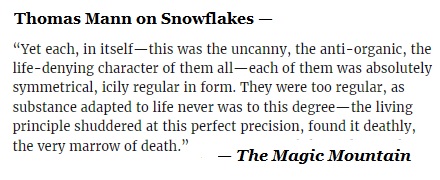

Some background . . .
A letter in The Mathematical Intelligencer, January 1988
http://www.log24.com/noindex-pdf/
Cullinane-letter-Artes_Liberales-Intelligencer.pdf —
The three nested icosahedra on the cover of
a recent vulgarized-mathematics book suggest . . .
This is, of course, a highly special case of the much more
general, and much more difficult, n-body problem .
|
From Gilles Châtelet, Introduction to Figuring Space Metaphysics does have a catalytic effect, which has been described in a very beautiful text by the mathematician André Weil: Nothing is more fertile, all mathematicians know, than these obscure analogies, these murky reflections of one theory in another, these furtive caresses, these inexplicable tiffs; also nothing gives as much pleasure to the researcher. A day comes when the illusion vanishes: presentiment turns into certainty … Luckily for researchers, as the fogs clear at one point, they form again at another.4 André Weil cuts to the quick here: he conjures these 'murky reflections', these 'furtive caresses', the 'theory of Galois that Lagrange touches … with his finger through a screen that he does not manage to pierce.' He is a connoisseur of these metaphysical 'fogs' whose dissipation at one point heralds their reforming at another. It would be better to talk here of a horizon that tilts thereby revealing a new space of gestures which has not as yet been elucidated and cut out as structure. 4 A. Weil, 'De la métaphysique aux mathématiques', (Oeuvres, vol. II, p. 408.) |
For gestures as fogs, see the oeuvre of Guerino Mazzola.
For some clearer remarks, see . . .
Illustrations of object and gestures
from finitegeometry.org/sc/ —
Object
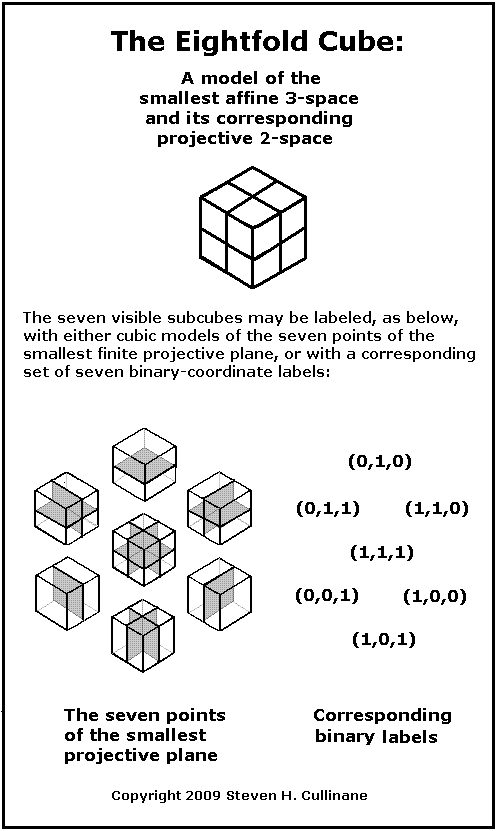
Gestures
An earlier presentation
of the above seven partitions
of the eightfold cube:
|
|
Related material: Galois.space .
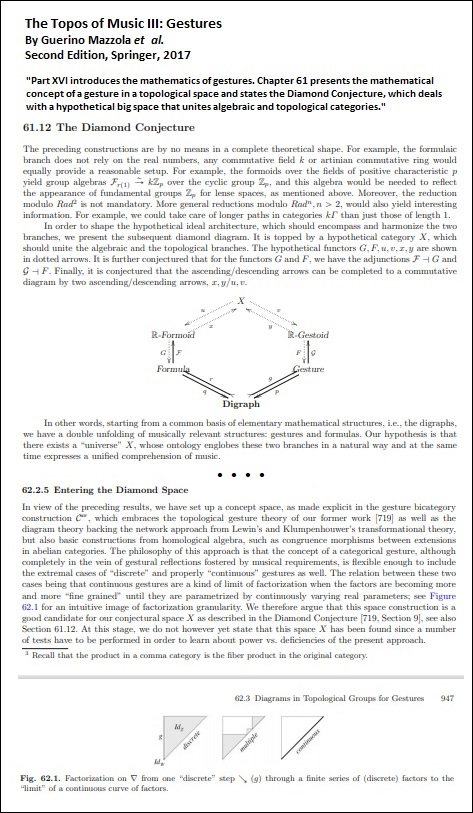
See also earlier references to Mazzola in this journal.
A sequel to the previous post, "How the Darkness Gets In" —
|
THE PHILOSOPHY OF RUDOLF CARNAP
EDITED BY PAUL ARTHUR SCHILPP
. . . . |
See also . . .
The extraordinary consequences of Einstein’s universe:
Relativity shatters our experience of time
9th January 2023
By Michael David Silberstein
"Professor of Philosophy at Elizabethtown College
and co-athor [sic] of Emergence in Context:
A treatise of twentry [sic] first-century natural philosophy
(Oxford University Press, 2022)."
"… the experience that there is something special about
the character of the present moment. This is what presumably
lead [sic] Einstein to say that
'there is something essential about the Now
which is just outside the realm of science.' "
Silberstein does not give any source for his quotation.
But see the passage from Carnap above.
I do not recommend taking Carnap's — or Silberstein's —
word for anything.
The source of Silberstein's remarks is a publication of an
organization called "Institute of Art and Ideas," or IAI.
Wikipedia on that organization:
"The IAI is responsible for organising the bi-annual festival
HowTheLightGetsIn, the biggest philosophy and music
festival in the world* aimed at 'tackling the dearth of philosophy
in daily life,' in addition to monthly IAI Live events."
* Maya Oppenheim (7 September 2021):
"HowTheLightGetsIn: The world's largest philosophy
and music festival to ask life's big questions."
The Independent.
Other social notes from that May weekend —
Some related reading for Cormac McCarthy —
The title refers to a post discussing a date,
that of last year's Feast of St. Thomas Becket.
Related material —
https://www.nytimes.com/2023/01/09/movies/ruggero-deodato-dead.html .
The tortoise of the previous post suggests . . .
"Is it the good turtle soup
or merely the mock?"
Related material from the above
Toronto premiere date —
From a link target in this journal on April 4, 2004 —
"Puzzle begun I write in the day's space . . . ."
Today's link targets —
Valéry and Rilke, Stevens and Borges . . . and Zeno.
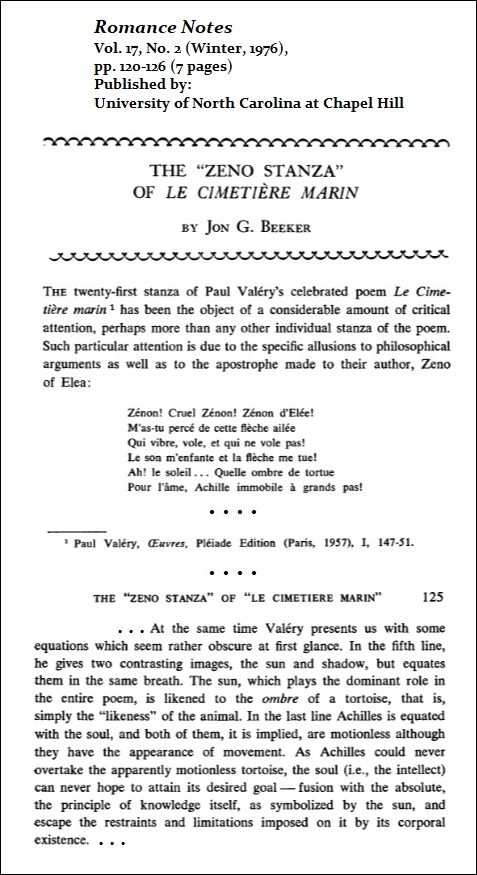
From AP News in The Derrick , Oil City, PA, today —
"Banks lived part of the year in Florida, and for a time
had a home in Jamaica, but he was essentially a man
of the North, with an old Puritan’s sense of consequences.
Snow fell often in his fiction . . . ." — Hillel Italie
Update of 3:33 PM ET —
From a link target in this journal on April 4, 2004 —
"Puzzle begun I write in the day's space . . . ."
Thandiwe Newton in "Reminiscence" (2021) —

The above film is from August 20, 2021.
From that same date —
"… just one aspect of a historical process
that we can legitimately call 'progress' –
not a romantic or utopian or naive ideal,
but an empirical fact that we can see
in graphs and numbers."
… and sometimes elsewhere . . .
"Might be a nice 20 page essay, but a bomb of a book"
— Herbert Gintis on Taleb's Black Swan , review dated April 10, 2012.
This remark might also be applied to Crumey's Mobius Dick :
Related material for Jungians who enjoy synchronicity —
The Log24 posts from the date of the Gintis review — April 10, 2012.

Tuesday, November 8, 2016, was also the publication date
at Princeton University Press for a book by one Herbert Gintis:
Gintis reportedly died yesterday, Jan. 5, 2023.
"He graduated from the University of Pennsylvania
and then attended Harvard University for post-graduate
work in mathematics. After receiving his master's degree,
he grew disillusioned with the field, and while at Harvard,
became a sandal maker with a shop in Harvard Square."
In later years, Gintis was associated with the Santa Fe Institute.

Pullman links in this journal —
http://m759.net/wordpress/?s=wsu.edu .
Specifically . . .
<a href="http://www.wsu.edu:8080/%7Edee/GLOSSARY/SHUCHUNG.HTM"
target="_new" rel="noopener noreferrer">
<strong><em>Shu</em>: Reciprocity</strong></a>
and
<a href="http://www.wsu.edu/%7Edee/GREECE/HERAC.HTM"
target="_new"><font size="6"><b>Logos</b></font></a>
Those links no longer work. See instead . . .
https://web.archive.org/web/20011224032243/
http://www.wsu.edu:8080/~dee/GLOSSARY/SHUCHUNG.HTM
and
https://web.archive.org/web/20011129072406/
http://www.wsu.edu/~dee/GREECE/HERAC.HTM .
Logo from these links:
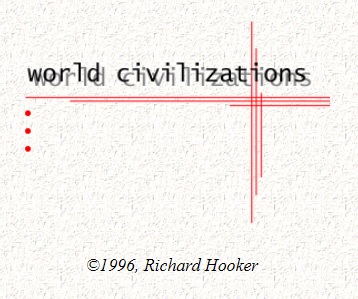
Wallace Stevens —
"Reality is the beginning not the end,
Naked Alpha, not the hierophant Omega,
Of dense investiture, with luminous vassals."
— “An Ordinary Evening in New Haven” VI

Powered by WordPress